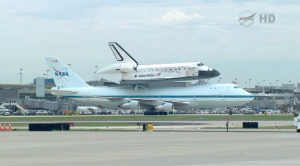 I really don’t know where this article is going, so bear with me here as I attempt to capture what is going on inside my head. As I’m writing this, I’m watching the Shuttle Discovery pull up to the cranes that will eventually lift it off it’s 747 ferry aircraft and transport it to it’s new home – the Udvar Hazy Annex of the Smithsonian Air & Space Museum. The shuttle program has ended some time ago, but I guess it’s end didn’t seem real until just now. I really didn’t want to be one of these sappy nostalgic people who are celebrating the remarkably long and mostly successful shuttle program, but it seems like I can’t ignore it.
I really don’t know where this article is going, so bear with me here as I attempt to capture what is going on inside my head. As I’m writing this, I’m watching the Shuttle Discovery pull up to the cranes that will eventually lift it off it’s 747 ferry aircraft and transport it to it’s new home – the Udvar Hazy Annex of the Smithsonian Air & Space Museum. The shuttle program has ended some time ago, but I guess it’s end didn’t seem real until just now. I really didn’t want to be one of these sappy nostalgic people who are celebrating the remarkably long and mostly successful shuttle program, but it seems like I can’t ignore it.
I was born on the southeast side of Houston, TX in 1970. For those who aren’t aware, that’s NASA country. Almost all of our neighbors growing up were employed by NASA. The Johnson Space Center was a scant few miles from my family’s home. When Apollo 13’s Jim Lovell spoke those immortal words, “Houston, we have a problem,” he was speaking to Mission Control just a few miles down the road from my house.
The years following 1970 were a time of transition as the Apollo program was ending in 1972. As a young child I had toys like plastic Apollo Rocket stacks and space helmets. But these toys would soon have to give way to a new generation of toys when the Space Shuttle Enterprise rolled out onto the runway in 1976. Every kid HAD to have his plastic Space Shuttle Enterprise!
In 1981 the shuttle Columbia made the first orbits of the shuttle program in STS-1. After the successful mission, the shuttle was ferried to Ellington AFB in Houston, not far from Mission Control. The public was invited to come out and take pictures of this heroic device atop it’s ferry aircraft. I remember standing next to it as a kid, looking up at the most sophisticated and amazing piece of equipment I’d ever seen! I remember thinking that we really were becoming a space-faring nation – just like on Star Trek! Since then, a number of shuttles were delivered to NASA: Challenger, Discovery, Atlantis, Endeavor. Shuttle missions became commonplace and the excitement faded into the background.
I remember being in Thompson Intermediate School in 1986 at the time the Challenger blew up a little over 1 minute after liftoff. This was a huge gut-shot for the nation, and Houston really felt it! Every classroom had a TV tuned to the local news, and I sat stunned, along with everyone else, as the news broadcast recounted those last few seconds before the blast. Nobody from my generation will ever forget that last televised radio transmission, “Challenger go at throttle up.” The image of the debris cloud is permanently engraved in our memories. The Endeavor was originally built to replace the Challenger, and soon after the return to flight 32 months later, orbital missions became routine again.
I also remember watching the news in 2003 when the Columbia broke up during reentry. Somehow a piece of foam insulation got dislodged from the external fuel tank and damaged the heat shielding on the leading edge of one of the wings. During reentry, hot gasses entered the wing and tore the shuttle apart. Once again the nation watched stunned as the news report showed the shuttle breaking up like a meteor shower. NASA didn’t have another orbital mission until STS-121 in 2005, with the shuttle Discovery. As always, these missions soon became routine again, and to be honest I never really thought about it much after that.
In 2011 the shuttle program was finally scheduled to end. By this time these spacecraft had already lasted well beyond the length of time that they were originally intended, and everyone knew it couldn’t last forever. Unfortunately we as a nation dropped the ball on a replacement program, so there is nothing to fill the space flight void but leased time on Russian rockets. As I watch the Discovery pull up to the cranes, I’m realizing that this truly is the end of an era – the era of US Manned Space Flight. The Manned Space Flight program was part of the soul of our nation, and now it feels like the dream is over. Yes, the shuttle program was hugely expensive. Yes there were some problems. But in spite of all this, the shuttle program, like the Apollo program before it, inspired a generation of kids to go into the fields of technology, science and engineering. We are reaping those benefits today! Without some form of inspiration for the next generation, I fear that we will become what we are already well on the road to being – a soulless nation of mindless consumer zombies.
What will inspire our next generation? A trip to the museum?? I doubt it.


